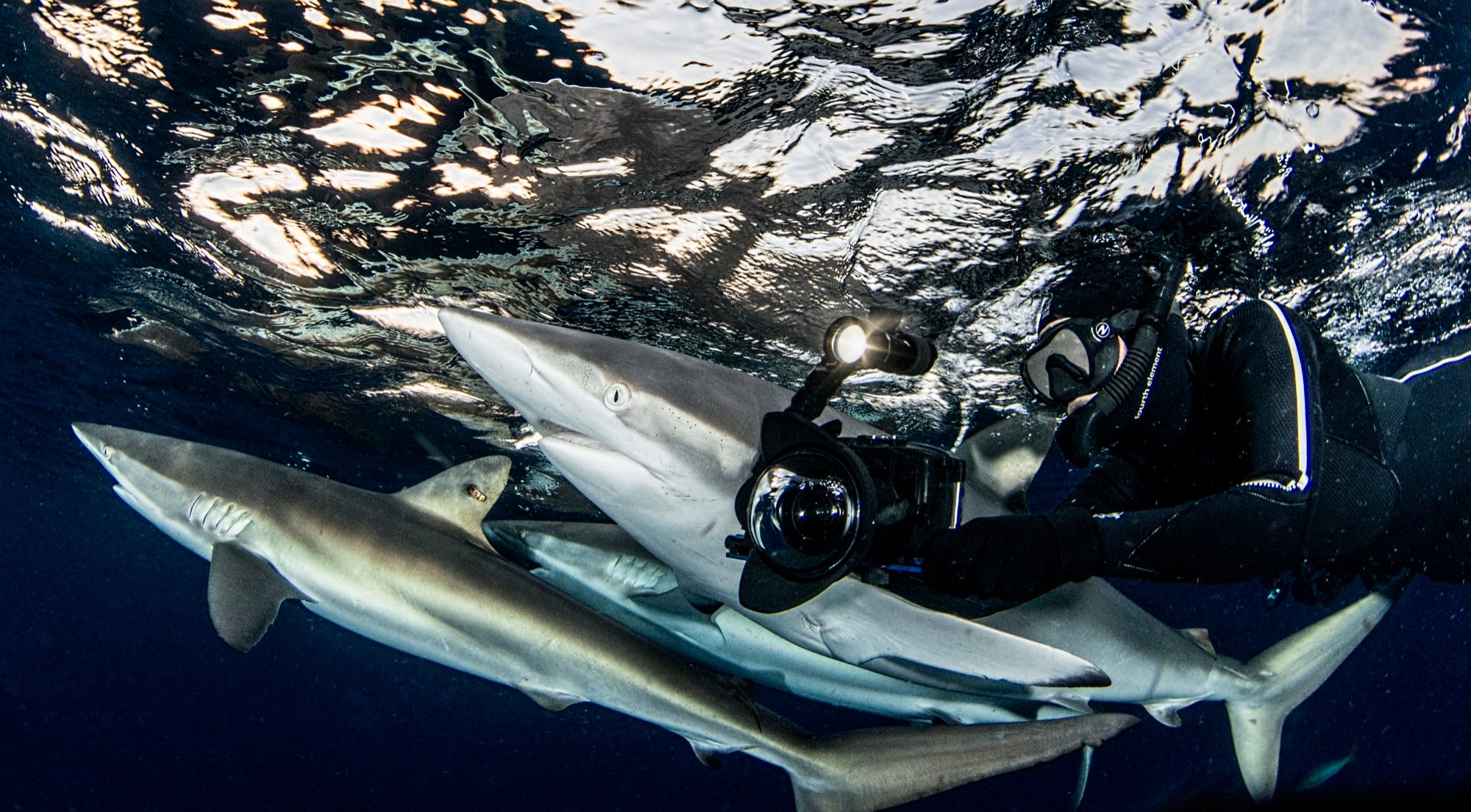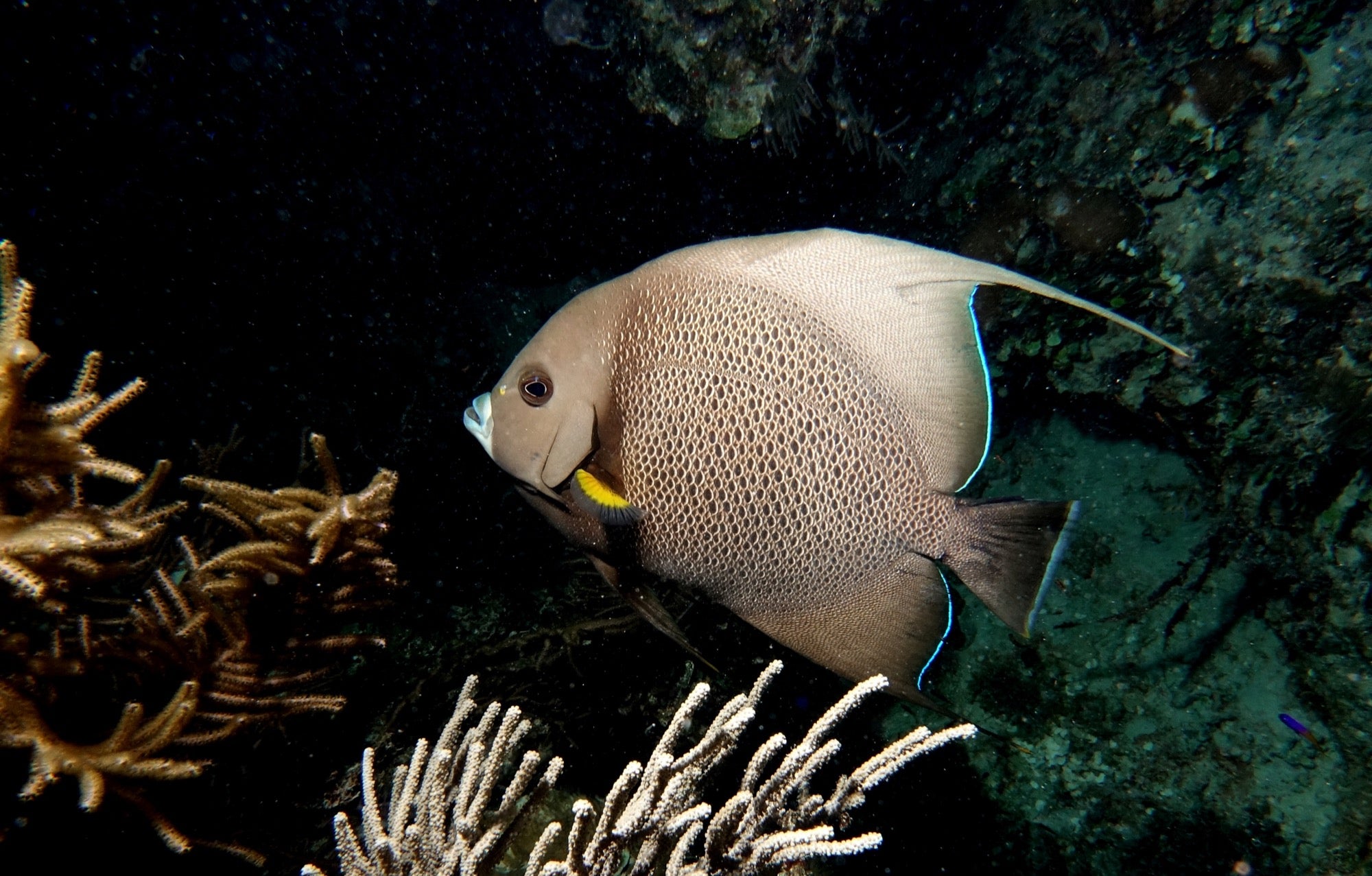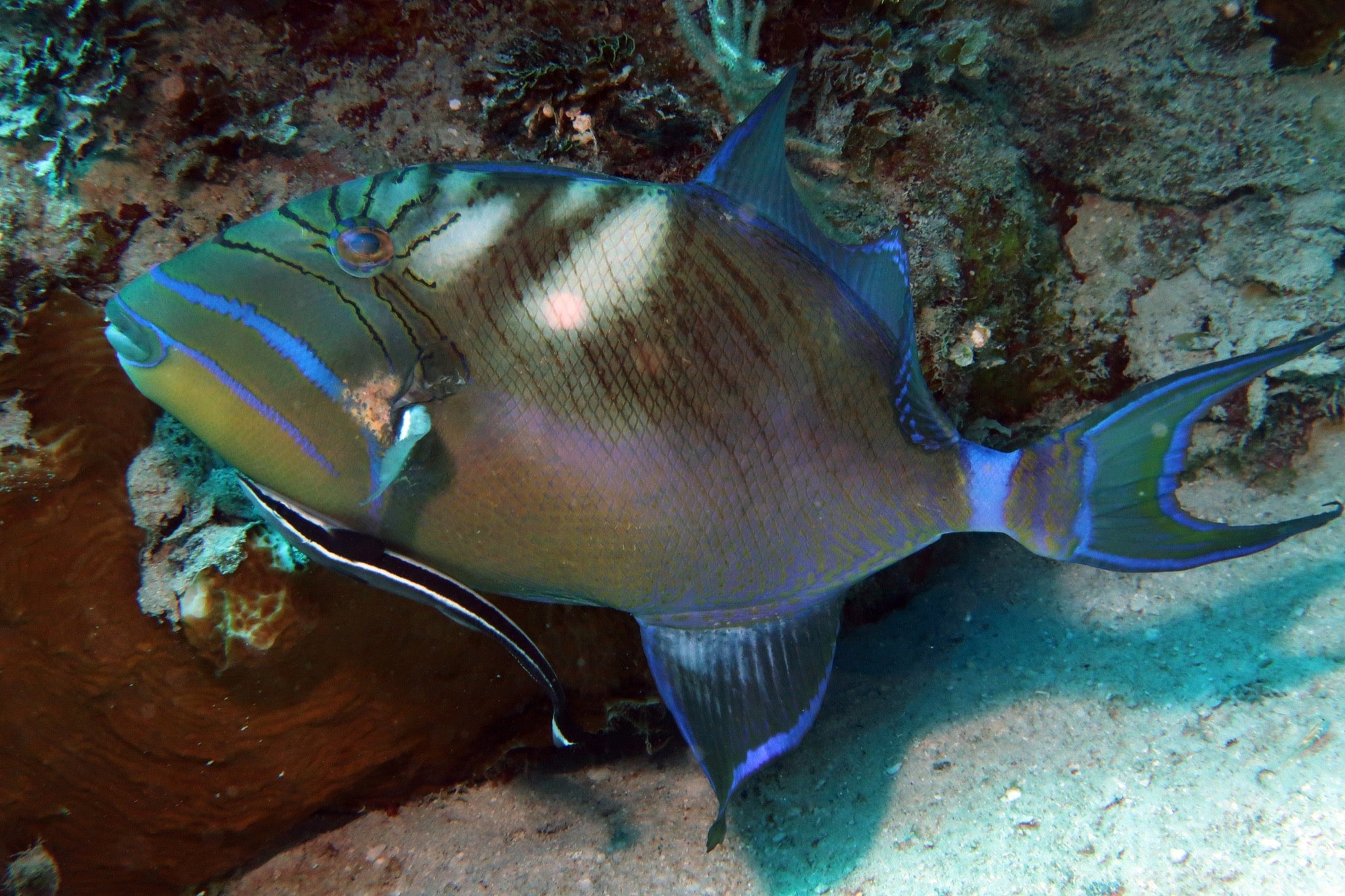by Howard Rosenstein
When Sony recently announced their Mark 5 model of the RX100 series I was eager to try it out. I previously had used the Mark 3 and Mark 4 models with great satisfaction. I was especially happy to learn that the Mark 5 had the same body configuration of the Mark 4 and would fit my Fantasea FRX100 lV housing.
I hoped the camera would arrive in time for a planned diving trip to the Gardens of the Queen archipelago located 50 miles off the south coast of Cuba. This Mangrove island chain is considered the very finest diving destination in the Caribbean and I couldn’t wait to get the new RX100 V into the water to capture its natural beauty. The camera arrived just a few days prior to my departure and I was good to go.
To further enhance the image quality and range of the camera/housing bundle, I also brought an assortment of accessories including Fantasea AOI wet lenses, the UWL-09F super wide angle and the UCL-09F macro lens. In addition I brought a red filter for natural light stills and video as well as several lights including an Inon Z-240 strobe, and the new Fantasea Radiant 3000F LED video and focus light. All of the above accessories work to enhance image range and quality.
Although I was traveling with a lot of gear—the camera, housing, wet lenses and lights--traveling with the RX100 V was a pleasure. The entire system including all the accessories mentioned above fit into a compact padded shoulder bag that was easily stored in the overhead luggage space above my plane seat. No overweight charges to worry about and no concerns about lost baggage!

The Sony RX100 V with Fantasea FRX100 IV housing and accessories.
Underwater 101
Underwater photography can be a very different experience from land-based shooting. Weightlessness and currents create obvious challenges and the seawater acts as a filter affecting white balance. Colors are lost the deeper you descend and as ambient sunlight diminishes there is a need for artificial lighting in order to regain the real colors of the exotic marine life. Without artificial lighting a lot of underwater images will appear without color, dark and with a blue or green hue.
Since it’s impossible to access the camera in the housing once submerged one can only change lenses underwater using specially designed waterproof “wet lenses” which attach externally on to the housing port. On-camera lenses are selected according to the specific conditions and characteristics of the subject being photographed. Water also magnifies size making subjects appear larger and closer than they really are. For example when using a camera with a 28mm wide angle lens underwater the effect of water magnification on the lens turns it into the equivalent of a 35mm wide lens. Using a wide angle wet lens on the housing port during the course of the dive allows for wider angles up to and including Fisheye coverage. Wide angle and macro photography are very popular in UW photography, accordingly macro and wide angle wet lenses are two of the most popular used.
I always take my first dive without the camera in the housing. This is a rule I follow simply because I want to be extra sure that nothing happened to the housing in transit and that everything is water tight. In Cuba, Murphy’s law showed up on my test dive without the camera. As I hit the water, I was surrounded by a school of beautiful silky sharks. Frustration set in as I was diving with these magnificent animals and I only had an empty housing. I was left with memories and visions of the incredible images I would not be capturing due to the lack of camera in the housing! The good news was the housing was bone dry and ready for a week of intensive diving.
Setup
With the checkout dive behind me I was ready to set up the system that I would be using for the rest of my dives. The Fantasea FRX100 lV housing that I was using is purpose-designed for the RX100 lll, lV and V, so the camera fits perfectly inside. With the camera secured in the housing I mounted the housing on a flat tray which serves as a platform for the rest of the accessory system. Flex arms are mounted on opposite ends of the tray to support the artificial lighting and optic accessories. Flex arms, as their name implies, can be adjusted to about any position to facilitate optimal lighting angles and effects. I decided to dive with a single strobe for still images and 2 high-powered LED video lights (with a combined power output of 6000 Lumens). One video light was mounted on a flex arm and the other on the cold shoe mount on the top of the housing. These powerful LED lights are essential for high quality color video and they can be used for fill lighting the stills.
I also mounted the wet lens holders on the flex arms to securely store the accessory lenses for quick placement on the housing when the right photo opportunity arose. These wet lenses allow for much more range, especially for super wide and macro images. I chose a fisheye for the big animal shots, an ultra sharp macro lens with a +12.5 diopter and a 67mm red filter for natural light stills and video. I realize this sounds like a lot of gear to be hauling around but underwater it’s nearly weightless and surprisingly compact especially compared to the huge DSLR rigs that a lot of underwater shooters use.
Over the following week we had 3-4 marvelous dives each day along the outer reefs of the Gardens Of The Queen with depths ranging from 60 ft. to 130 ft.. I had the opportunity to photograph schools of graceful silky and Caribbean reef sharks, giant Goliath groupers as large as a diver, barracudas, rays, very friendly green and hawksbill turtles, moray eels, tarpon, a spectacular variety of beautifully colored tropical fish and exquisite hard and soft coral formations. The larger fish, especially the sharks and salt water crocs found in the lagoons, required the wide angle wet lens, the medium size tropical fish were captured with the RX100 V’s on board 24-70mm zoom lens. For the little critters found living in and around the corals the RX100 V’s close up capabilities were impressive. For the super tight macro shots I enhanced that capability even further with my UCL-09F Macro Lens and its +12.5 Diopter. Strobe and LED video lighting was used on every dive except for the natural light shots when I used the red filter.
In the Water: Stills, 4K Video & Super Slow Mo
One of the best features of the RX100 V is the total ease with which I could switch from stills to video capture. I found this especially helpful when shooting the schools of silky sharks. The action was very fast and dramatic and, as a photographer, it’s really a dilemma whether to go for stills or for video action. With the RX100 V, it was easy and fast to switch between modes quickly.
Sharks move fast and they make a challenging subject for any camera’s AF system. The RX100 V’s new AF system kept up and tracked the sharks better than I expected giving me a surprising number of sharp shots.
The RX100 V’s 4K video is also a great feature to have especially when shooting such a fast, adrenaline-charged experience. I want to be certain I capture it in the highest quality video found in any compact camera.
I found the slow motion feature (960 fps) to be really excellent when shooting the sharks. This creates a dramatic effect with the action slowed down and it allows you observe these magnificent animals in detail.
I also explored and dived the mangrove channels and pools. These are very shallow areas and present difficult conditions including occasional poor visibility when the silt is stirred up. Because the housing system is so compact it was much easier to maneuver through the mangroves to clearer areas and position the camera to photograph the small tropical fish living there.
I also managed to go on a few night dives using my Fantasea Radiant 3000F LED video light with a blue/UV light. This allows me to view and capture the amazing fluorescence found in some corals and other marine life. For this type of diving, ramping up the ISO over 1000 is essential. The RX100 V’s low light capability did an amazingly-good job.
I couldn’t wait to download my images every night to make sure what I shot during the day turned out as I had hoped. I wasn’t disappointed! I found the RX100 V was up to the task in every way. Still images were of the highest quality, extremely sharp and with vibrant colors.
This trip to the Gardens Of The Queen gave me a unique opportunity to evaluate the RX100 V for underwater stills and video. I found that it’s an amazing high-quality compact camera that’s perfect for the rigors and challenges of underwater photography. In my opinion it’s the best compact camera for underwater photography on the market today.
Grey angelfish. Sony RX100 V. 1/2000-sec., f/10, ISO 500.
This image was taken with afternoon light. I closed the aperture down to get good contrast between the artificially illuminated fish and the dark background. Lighting was provided by an Inon X240 strobe and 2 Fantasea Radiant 3000F LED video lights.
Silky shark. Sony RX100 V. 1/800-sec, f/5.6 ISO 800.
Early morning light, fast speed and high ISO. In most diving destinations, if you see one shark on a dive, it’s the highlight of the dive and if you can capture an excellent image, it makes your day. At the Gardens of the Queen, you are guaranteed to see many sharks on nearly every dive along the outer reefs where the silky sharks swim in schools of 20 or more. When photographing sharks, it’s important to get as close as possible to the subject using a good wide angle lens and then to choose the most dynamic angle and use the blue sea as a background to capture the unique beauty of this apex predator.

Photo by Ron Watkins of UW Photo Pro Amanda Cotton Snorkeling with the silky sharks using the Sony RX100 V in the Fantasea FRX100 lV housing and super wide angle UWL-09F wet lens.
Black grouper with diver. Sony RX100 V. 1/500-sec., f/10 ISO 800.
Diving around the world, I have found that groupers tend to shy away from the divers, especially if there has been spear-fishing practiced in the area. It’s often very hard to get close and to frame the image and the have the time and opportunity to select the correct angle. Trying to shoot slightly upward to capture definition and not lose the image of the fish in the background of the coral reef is the goal. When there’s a diver in the image, I try to put the animal in front of the diver to get a more dramatic perspective of its size. In this image, posing the diver just behind the black grouper, I used my strobe and video light to illuminate the fish and the natural sunlight to illuminate the background.
Black grouper sitting on the sandy bottom. Sony RX100 V. 1/400-sec., f/10 ISO 400.
I found a nice large grouper sitting on the sandy bottom. I cautiously approached so as not to startle it and drive it away. I started shooting photos from about 10 feet away to guarantee at least one usable image. On occasion I use the camera’s zoom, but the very best results are gained by getting as close as physically possible to the fish and eliminating the amount of water between you and the subject. Advancing ever so slowly, I continued taking images until I was literally within touching distance of this grouper.
Mangrove trees. Sony RX100 V. 1/1600-sec., f/7.1 ISO 1000.
Aside from the wonderful coral reef ecology of the Gardens of the Queen, it has a vast archipelago of Mangroves creating channels and lagoons to explore and photograph. These impressive trees are able to “desalinate” salt water to survive in the marine environment. They create an exciting and interesting eco system with many birds, labyrinths of channels and pools where you can meet just about any animal you find on the outer reefs and some that you don’t such as salt water crocodiles and small marine life found only in the protection of the lagoon. The roots of the mangroves, which are for the most part exposed, serve as nurseries for small tropical fish until they are big enough to venture out to open water. I love diving and snorkeling in the mangroves. In this image I was lifting my housing out of the water to a catch a glimpse of our dive panga, and I used the mangroves to frame a picture.
Spiny head blenny. Sony RX100 V. 1/400-sec., f/10 ISO 1000.
Spiny head blennies are very small fish living inside a sponge or coral. One needs to be extremely patient and steady when approaching these fish as they withdraw into their “home” in a split second, totally disappearing from the frame. In this image, I used the zoom feature to bring me in as close as I could get to the fish. To capture these small critters it’s often beneficial to use wet macro lenses. To capture this shot I used the Fantasea AOI UCL-09F Macro lens with a diopter of +12.5.
Queen trigger fish with a remora fish. Sony RX100 V. 1/640-sec., f/9 ISO 800.
One of my very favorite things to photograph under water is animal behavior. In this image, I managed to capture the symbiotic interaction between a beautiful queen trigger fish with a small remora fish (sometimes called a sucker fish). This is an example of the symbiotic relationship between two animals. The remora attaches to the belly of the Queen Trigger by a sucker disc on its flat head and it eats any parasites on the queen trigger. The remora gets dinner and the queen trigger stays clean and healthy.
All images taken using the Sony RX100 V compact in a Fantasea Line FRX100 lV Housing and were shot at the Garden of the Queen Nature Reserve, Cuba. All of the pictures in this gallery were either shot with artificial lighting, a strobe in addition to LED video lights or in natural light conditions using a red filter, especially when shooting wide angle in video mode.
Howard Rosenstein is an award-winning underwater photographer and explorer. He is the president of Fantasea Line, Underwater Photo Accessory Company and a pioneer of diving tourism to the Red Sea and Indian Ocean. He’s a member of the International SCUBA Diving Hall of Fame.










